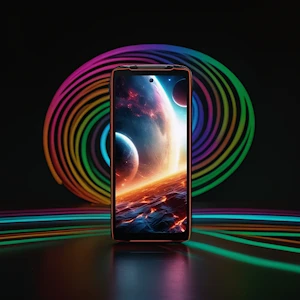The Blackview BV8200: A Tank That Lasts for Days (But Bring a Big Pocket)
Let me start with the obvious: this isn’t your average smartphone. The Blackview BV8200 is built like a brick wrapped in Gorilla Glass, and that’s exactly the point. If you’ve ever cracked a screen by dropping your phone from knee height, or panicked when rain started falling mid-text, this phone’s here to laugh in the face of danger. But is it right for you? Let’s break it down.
The Rugged Reality
First, the elephant in the room: this thing is chonky. At 16.5mm thick and 370 grams, it feels like carrying a small paperback book. The polycarbonate body and raised bezels scream "I’ve been dropped down a staircase and lived to tell the tale." The IP68/IP69K ratings mean it’ll survive mud, dust, and a 30-minute dunk in water. Want to rinse it under a faucet after a hike? Go nuts. But that durability comes at a cost: the 6.5" screen only uses 72% of the front face, so you’re getting iPhone 13 mini vibes in a body twice as thick.
The 120Hz LCD display is a pleasant surprise. Scrolling feels smooth, and colors are decent (though not OLED-level vibrant). But here’s the catch: that 500-nit brightness struggles under direct sunlight. Picture squinting at Google Maps on a desert hike – it’ll work, but you’ll wish for Samsung’s 1,500-nit punch.
Performance: Workhorse, Not Racehorse
Under the hood, the MediaTek Helio G100 chip and 12GB RAM sound beefy on paper. In practice? It’s like a reliable pickup truck: great for hauling everyday tasks, but don’t expect Formula 1 speeds. Apps like Spotify and WhatsApp open fast, and switching between them is seamless. But try playing Genshin Impact on max settings, and you’ll notice frame drops – the Mali-G57 GPU just can’t keep up. That built-in cooling system helps, though. After an hour of gaming, the back stays lukewarm, not fry-an-egg hot like some flagships.
The real star? The 8,800mAh battery. This thing lasts like a Netflix binge session. I streamed 14 hours of video (brightness at 70%) and still had 20% left. For normal use? You’re looking at 2-3 days between charges. And when you do plug in, the 45W charging gets you from 0-50% in 35 minutes. Bonus: it doubles as a power bank for your earbuds. Perfect for camping trips where outlets are mythical creatures.
Cameras: Daylight Hero, Nighttime Zero
The 50MP main camera (Samsung GN5 sensor) shines in daylight. Photos are crisp, colors pop without looking cartoonish, and the OIS helps stabilize shaky hands. The 13MP macro/wide-angle lens is fun for bug photography or group shots, but details get mushy past 2x zoom. At night? Let’s just say you’ll miss Google’s Night Sight. Shots turn grainy, and the dual-LED flash blows out faces like a horror movie jump-scare.
The 32MP selfie cam? It’s serviceable. Skin tones look natural in good light, but low-light selfies require Jedi-level stillness. And no, there’s no 4K video – maxes out at 1080p/30fps. Fine for TikTok dances, not so much for indie filmmaking.
Who’s This For?
Buy it if:
- You work construction, hike often, or have a talent for breaking phones
- You need a device that’ll last a weekend off the grid
- You want Android 14 without Samsung/Google’s bloat
Avoid it if:
- You care about sleek design or pocket space
- You’re a mobile photographer chasing Milky Way shots
- You need 5G (this is strictly 4G territory)
The Verdict: My Personal Take
If I worked on an oil rig or backpacked through rainforests monthly? I’d buy this in a heartbeat. The battery life alone is revolutionary, and the ruggedness feels genuinely trustworthy. But as a city-dweller who occasionally drops phones on sidewalk cracks? The compromises sting. The weight gives me wrist fatigue during long reads, and the camera can’t keep up with my toddler’s nighttime dance parties.
Still, at ~€225, it’s a steal for its niche. Think of it as the Jeep Wrangler of smartphones – not refined, not fancy, but damn good at what it’s built for. Just make sure your pants have big pockets.
